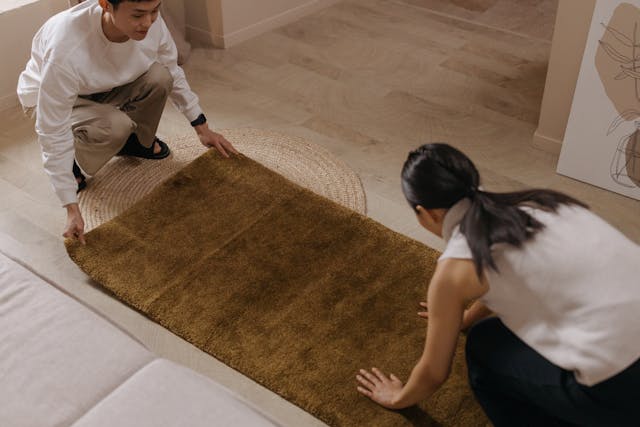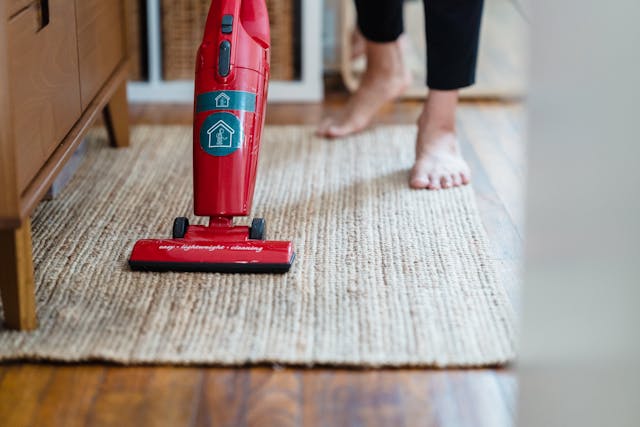Imagine your area rug as a canvas that captures the footprints of your daily life, each stain and spot a testament to memories made. You’re likely seeking ways to erase these marks without emptying your wallet. Fortunately, there’s a treasure trove of inexpensive cleaning methods right in your home, from the humble vacuum to the mighty power of baking soda and vinegar.
But how exactly do you leverage these tools for the best results? Let’s embark on a journey to uncover the secrets to reviving your rug’s vibrancy, ensuring it remains a vivid backdrop to your life’s moments, without the need for costly interventions.
Basic Rug Maintenance Tips
To keep your area rug in top condition, regularly vacuuming it can prevent the buildup of dirt and debris. This simple step not only keeps the rug looking fresh but also reduces the potential for allergens to become trapped in the fibers. Especially if you have pets, using a brush to remove pet hair can further minimize allergens and maintain the cleanliness of your rug.
Another key maintenance tip is to turn your rug every year. This practice helps to distribute wear and tear more evenly across the rug, significantly extending its lifespan. By doing so, you ensure that no single area of the rug suffers from excessive use.
For smaller area rugs, don’t underestimate the power of a good shake. Taking the rug outside and shaking it vigorously can dislodge dirt and grit that vacuuming alone may not remove. However, it’s crucial to be mindful of local ordinances regarding shaking rugs outdoors to ensure you’re not violating any regulations.
DIY Stain Removal Solutions
Removing stains from your area rug doesn’t have to be a daunting task, especially when you can create effective DIY solutions using household items. With a few simple ingredients, you can tackle various stains and keep your rug looking clean and fresh. Here are some tried-and-true methods:
- Vinegar Solution: Mix equal parts white vinegar and water to create a versatile stain removal solution. This mixture is particularly effective for light stains and can help refresh the overall look of your area rug.
- Baking Soda Paste: For tougher stains, mix baking soda with water to form a paste. Apply this directly to the stain, let it sit for a few minutes, then gently scrub and rinse. Baking soda not only helps lift the stain but also eliminates odors.
- Special Mixtures for Stubborn Stains:
- Dilute mild dish soap in water for a gentle yet effective stain remover.
- Sprinkle cornstarch over greasy or oily stains to absorb the residue before vacuuming.
- For the most stubborn stains, a mixture of hydrogen peroxide and dish soap can work wonders. Apply, let it act, then dab away the stain.
Utilizing Household Cleaners
You’ve likely got a goldmine of cleaning solutions right in your pantry for keeping your area rug fresh and clean. From using a simple mixture of mild detergent and water for small stains to harnessing the power of white vinegar for odor removal, these common household items can work wonders. We’ll explore how everyday ingredients like baking soda and enzyme cleaners can tackle everything from odors to tough stains, providing an effective, low-cost way to maintain your rug.
DIY Cleaning Solutions
For an affordable and effective way to clean your area rug, consider making your own DIY cleaning solutions using common household items. Here’s how you can leverage what you already have at home:
- Equal Parts Water and Vinegar: Mix these for a cost-effective rug cleaner that’s gentle yet effective.
- Mild Dish Soap and Warm Water: This combo is perfect for tackling stubborn stains without harsh chemicals.
- Baking Soda for Deodorizing: Simply sprinkle on your rug, wait, and then vacuum up to eliminate odors naturally.
Adding a few drops of essential oil or lemon juice to your solutions can further enhance their cleaning power and leave your area rug looking and smelling fresh. These simple, DIY cleaning solutions provide a budget-friendly approach to maintaining your rug in top condition.
Common Ingredient Uses
Harnessing the power of common household cleaners, you’ll find that tackling stains and odors on your area rug is both simple and effective. These ingredients not only clean but often do so in a natural, gentle manner. Here’s how to use each one:
| Ingredient | Use |
|---|---|
| Baking Soda | Absorbs odors, lifts stains |
| White Vinegar | Acts as a natural disinfectant, removes tough stains |
| Dish Soap & Water | Breaks down dirt |
| Hydrogen Peroxide | Removes organic stains like blood or wine |
| Lemon Juice | Helps lighten and brighten, especially with sunlight |
Washing Techniques by Material
Selecting the right washing technique for your area rug depends on its material, ensuring it stays clean without damage. Different materials require unique approaches to remove dirt and stains effectively while keeping the rug in prime condition. Here’s how to tackle cleaning an area rug based on its material:
- Wool and Cotton Rugs: For these natural fibers, hand-washing is your best bet. Mix a mild detergent with cold water and gently scrub. This method helps you control the amount of water and cleaner used, reducing the risk of damage. Always air dry wool rugs to prevent shrinkage and distortion.
- Synthetic Rugs: These are more durable and can handle a bit more vigor during cleaning. You can use a mild detergent solution to hand-wash these rugs. They’re less prone to damage from water, making them easier to clean at home. Spot clean when necessary to extend the time between full washes.
- Silk and Antique Rugs: For delicate silk or valuable antique rugs, spot clean with a damp cloth and mild soap. Due to their delicate nature and intricate designs, consider professional cleaning to preserve their beauty and integrity without risking damage.
Each material requires a tailored approach to ensure your rug stays vibrant and clean without the need for costly repairs.
Drying and Odor Prevention
Once you’ve washed your area rug, it’s crucial you dry it properly to avoid any damage or lingering odors.
Hang it outside in a spot that’s airy yet out of direct sunlight, and remember to flip it to ensure both sides dry evenly.
Using fans or opening windows can also help speed up the process, especially in damp conditions, ensuring your rug smells fresh when it’s time to bring it back inside.
Effective Drying Techniques
To effectively dry your area rug and prevent odors, you’ll find air drying to be the most economical and efficient method. Here’s how to ensure a thorough drying process:
- Hanging Outdoors: For quicker drying, hang the rug on a sturdy clothesline. This allows air to circulate freely on both sides, speeding up the drying.
- Fans or Dehumidifier: Inside, use fans or a dehumidifier to help remove moisture from the air, especially in humid conditions. This accelerates the drying process without risking damage to the rug fibers.
- Avoid Direct Sunlight: While air drying, ensure the rug isn’t in direct sunlight to prevent fading and fiber damage.
Proper drying techniques like these prevent mold and mildew and help eliminate lingering odors, keeping your rug fresh and clean.
Odor Elimination Tips
After cleaning your area rug, it’s crucial to dry it thoroughly to prevent any lingering odors. Odor elimination starts with thorough drying. Use fans or open windows to enhance air circulation, which can significantly speed up the drying process and reduce the risk of lingering odors.
Placing your rug in direct sunlight not only speeds up drying but also helps naturally kill bacteria that cause odors, freshening up the fibers. For an extra freshness boost, sprinkle baking soda over the rug; it’ll absorb and neutralize odors, leaving your rug smelling fresh.
To prevent future odors, keep the rug in a well-ventilated area and tackle spills quickly to avoid mold and mildew growth.
Regular Care and Prevention
Maintaining your area rug through regular care and prevention can significantly reduce the need for expensive cleanings later on. By incorporating a few simple habits into your cleaning routine, you’ll not only keep your rug looking its best but also extend its lifespan and minimize the need for professional cleaning services. Here’s how you can achieve this:
- Vacuum Regularly: Make it a habit to vacuum your area rug at least once a week. Use a gentle brush attachment to avoid damaging the fibers. This simple step helps prevent dirt buildup, which can lead to stains and odors.
- Rotate and Shake Out: To ensure even wear and prevent premature damage, rotate your area rug at least once a year. For smaller rugs, take them outside and shake them out thoroughly to remove any trapped dirt and grit. Always check local ordinances to make sure shaking rugs outdoors is permitted in your area.
- Remove Pet Hair: Use a gentle brush to remove pet hair. This will keep your rug clean and looking fresh, further extending its life and reducing the necessity for costly cleanings.
Additional Details
- Be sure to learn more about professional carpet cleaners
- Also learn how to deal with frustrating coffee stains
Conclusion
In conclusion, keep your area rug looking its best without spending a fortune. Regularly vacuum and tackle spills quickly with mild detergent or white vinegar solutions. Don’t forget the power of baking soda for beating odors.
Depending on the rug’s material, adjust your washing technique, but always ensure proper drying to prevent damage. By incorporating these simple, cost-effective strategies into your routine, you’ll extend the life of your rug and maintain its freshness and beauty.




